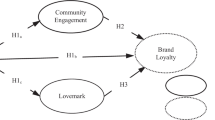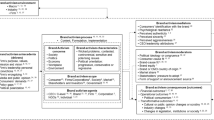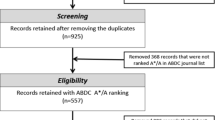Abstract
The aim of this work is twofold: on the one hand, it consists of determining the main elements of the Morocco brand constructed and transmitted by Moroccan emigrants, and on the other it explores whether this brand is convergent and coherent or, on the contrary, diverges depending on the socio-demographic profile of Moroccan emigrants. To achieve these objectives, data from 131 Moroccan emigrants living in Spain were collected through a questionnaire. The findings sum up the most relevant factors of the Morocco brand transmitted by emigrants to the local population in Spain. These elements are: environment, infrastructures and activities, culture and innovation, as functional attributes of the country brand; and the contrast of old and new life, including hospitality, religion, traditions but also modernity, cosmopolitism and multiculturalism, and lifestyle as emotional attributes. Moroccan emigrants highlight emotional attributes more than functional ones to characterise Morocco. Our data also show that Moroccan emigrants construct and transmit a convergent and coherent brand, despite their differences in age, gender and education. At a theoretical level, we conclude that this work contributes to a scarce literature on the analysis of destination branding from an internal point of view, and more specifically with regard to the role of migration on the brand construction. Moreover, from a practical point of view this study offers important insights to be considered by destination management organisations (DMO) in order to align all the multiple voices from different stakeholders of a destination brand into a coherent and non-contradictory message. In addition, this study entails implications for DMO regarding the appropriate use of emigrants as potential ambassadors of a destination brand.
Similar content being viewed by others
References
Aaker, D.A. (1996) Building Strong Brands. New York: Free Press.
Alegre, J. and Garau, J. (2010) Tourist satisfaction and dissatisfaction. Annals of Tourism Research 34 (1): 52–73.
Andriotis, K. and Vaughan, D.R. (2003) Urban residents’ attitudes towards tourism development: The case of Crete. Journal of Travel Research 42 (2): 172–185.
Baker, B. (2007) Destination Branding for Small Cities: The Essentials for Successful Place Branding. Portland, OR: Creative Leap Books.
Balakrishnan, M.S. (2009) Strategic branding of destinations: A framework. European Journal of Marketing 43 (5/6): 611–629.
Baloglu, S. and McCleary, K.W. (1999) US international pleasure travelers’ images of four Mediterranean destinations: A comparison of visitors and non-visitors. Journal of Travel Research 38 (2): 144–152.
Beerli, A. and Martin, J.D. (2004) Factors influencing destination image. Annals of Tourism Research 31 (3): 657–681.
Bennett, R. and Savani, S. (2003) The rebranding of city places: An international comparative investigation. International Public Management Review 4 (2): 70–87.
Braun, E., Kauaratzis, M. and Zenker, S. (2013) My city – my brand: The different roles of residents in place branding. Journal of Place Management and Development 6 (1): 18–28.
Campelo, A., Aitken, R., Gnoth, J. and Thyne, M. (2009) Place Branding: Representing Sense of Place. Proceedings of the Australian and New Zealand Marketing Academy Conference; 30 November – 2 December, Canning Bridge, Australia: Australian and New Zealand Marketing Academy.
Casado, B.L., Hong, M. and Harrington, D. (2010) Measuring migratory grief and loss associated with the experience of immigration. Research on Social Work Practice 20 (6): 611–620.
Chen, C.F. and Tsai, D. (2007) How destination image and evaluative factors affect behavioural intentions? Tourism Management 28 (4): 1115–1122.
Croes, R., Lee, S.H. and Olson, E.D. (2013) Authenticity in tourism in small island destinations: A local perspective. Journal of Tourism and Cultural Change 11 (1/2): 1–20.
D’Angela, F. and Go, F.M. (2009) Tale of two cities’ collaborative tourism marketing: Towards a theory of destination stakeholder assessment. Tourism Management 30 (3): 429–440.
El aouni, F., Cascón-Pereira, R. and Hernández-Lara, A.B. (2013a) The role of emigrants in the construction of a destination brand: A new research line. Tourism and Hospitality Management 19 (1): 35–47.
El aouni, F., Cascón-Pereira, R. and Hernández-Lara, A.B. (2013b) Building the Morocco brand as a tourist destination: The role of emigrants and institutional websites. Journal of Urban Regeneration and Renewal 6 (3): 252–263.
El Wartiti, M., Malaki, A., Zahraoui, M., El Ghannouchi, A. and Di Gregorio, F. (2008) Geosites inventory of the Northwestern Tabular Middle Atlas of Morocco. Environmental Geology 55 (2): 415–422.
Freire, J.R. (2009) Local people a critical dimension for place brands. Brand Management 16 (7): 420–438.
García, J.A., Gómez, M. and Molina, A. (2012) A destination-branding model: An empirical analysis based on stakeholders. Tourism Management 33 (3): 246–261.
Govers, R. and Go, F.M. (2004) Cultural identities constructed, imagined and experienced: A three-gap tourism image model. Tourism 52 (2): 165–182.
Govers, R., Go, F.M. and Kumar, K. (2007) Promoting tourism destination image. Journal of Travel Research 46 (1): 15–23.
Hankinson, G. (2004) Relational network brands: Towards a conceptual model of place brands. Journal of Vacations Marketing 10 (2): 109–121.
Haug, B., Dan, G.M.S. and Mehmetoglu, M. (2007) Little Norway in Spain, from tourism to migration. Annals of Tourism Research 34 (1): 202–222.
Houghton, J.P. and Stevens, A. (2011) City branding and stakeholders engagement. In: K. Dinnie (ed.) City Branding: Theory and Cases. Basingstoke, UK: Palgrave Macmillan, pp. 45–53.
INE. (2013) Datos extraides de la base de datos del Instituto Nacional de Estadística, Madrid, Accessed 20 May 2013.
Iversen, N.M. and Hem, L.E. (2008) Provenance associations as core values of place umbrella brands: A framework of characteristics. European Journal of Marketing 42 (5/6): 603–626.
Janta, H. (2011) Polish migrant workers in the UK hospitality industry: Profiles, work experience and methods for accessing employment. International Journal of Contemporary Hospitality Management 23 (6): 803–819.
Janta, H., Brown, L., Lugosi, P. and Ladkin, A. (2011b) Migrant relationships and tourism employment. Annals of Tourism Research 38 (4): 1322–1343.
Janta, H., Ladkin, A., Brown, L. and Lugosi, P. (2011a) Employment experiences of polish migrant workers in the UK hospitality sector. Tourism Management 32 (5): 1006–1019.
Johansson, O. and Cornebise, M. (2010) Place branding goes to the neighbourhood: The case of pseudo-Swedish Andersonville. Geografiska Annaler (B) 92 (3): 187–204.
Joppe, M. (2012) Migrant workers: Challenges and opportunities in addressing tourism labour shortages. Tourism Management 33 (3): 662–671.
Kaplan, M.D., Yurt, O., Guneri, B. and Kurtulus, K. (2010) Branding places: Applying brand personality concept to cities. European Journal of Marketing 44 (9/10): 1286–1304.
Kavaratizis, M. (2012) From necessary evil to necessity: Stakeholders’ involvement in place branding. Journal of Place Management and Development 5 (1): 7–19.
Kendall, K.W. and Gursoy, D. (2007) Managerial approach to positioning and branding: Eponymous of efficient. Tourism Analysis 12 (5/6): 473–483.
Konecnik, M. and de Chernatony, L. (2013) Developing and applying a place brand identity model: The case of Slovenia. Journal of Business Research 66 (1): 45–52.
Konecnik, M. and Go, F. (2008) Tourism destination brand identity: The case of Slovenia. Journal of Brand Management 15 (3): 177–189.
López-Lara, E. (2005) La imagen turística de Marruecos proporcionada por internet: Reinterpretando el orientalismo. Cuadernos de Turismo 16 (1): 123–134.
McClinchey, K.A. (2008) Urban ethnics festivals, neighbourhoods, and multiple realities of marketing place. Journal of Travel and Tourism Marketing 25 (3/4): 251–264.
Pike, S. (2010) Destination branding case study: Tracking brand equity for an emerging destination between 2003 and 2007. Journal of Hospitality and Tourism Research 34 (1): 124–139.
Pike, S. (2012) Destination positioning opportunities using personal values: Elicited through the repertory test with laddering analysis. Tourism Management 33 (1): 100–107.
Pitt, L.F., Opoku, R., Hultman, M., Abratt, R. and Spyropoulou, S. (2007) What I say about myself: Communication of brand personality by African countries. Tourism Management 28 (3): 835–844.
Salazar, N.B. (2012) Community-based cultural tourism: Issues, threats and opportunities. Journal of Sustainable Tourism 20 (1): 9–22.
San Martín, H. and Rodríguez, I. (2010) The stimulus and personal factors in the formation of destination brand image: An application to the tourists visiting a holiday destination. Cuadernos de Economía y Dirección de Empresa 13 (43): 37–64.
Sartori, A., Mottironi, C. and Corigliano, M.A. (2012) Tourist destination brand equity and internal stakeholders: An empirical research. Journal of Vacation Marketing 18 (4): 327–340.
Shanka, T. (2001) Tourist destination slogans as unique selling propositions: The case of African tourism. Tourism Analysis 6 (1): 53–60.
Sheth, A. (2010) Little India, next exit: Ethnic destinations in the city. Ethnografy 11 (1): 69–88.
Singh, A. (1995) Contradictions in consciousness or variations in tradition: Hindu women in the South African diaspora. Guru Nanak Journal of Sociology 16 (2): 95–126.
Tiesler, N.C. and Cairns, D. (2007) Representing Islam and Lisbon youth Portuguese muslims of Indian-Mozambican origin. Lusotopie 14 (1): 223–238.
Woosman, K. (2013) Using emotional solidarity to explain resident’s attitudes about tourism and tourism development. Journal of Travel Research 51 (3): 315–327.
Yen, C.J. (2013) Sport, diplomacy, and the role of an athlete as ambassador. International Journal of the History of Sport 30 (9): 1008–1021.
Author information
Authors and Affiliations
Additional information
1has a degree in Private Law (Mohammed V University, Rabat, Morocco) and a Master’s degree in Tourism Planning and Management (Rovira i Virgili University (URV), Tarragona, Spain). She is a PhD student at URV, currently working on her PhD thesis about ‘Building the Morocco brand as a tourist destination: the role of emigrants’. El aouni is also member of the Research Group on Economy and Tourism, which is part of the Department of Business Management at URV.
2has a degree in Business Management and Administration (University Rovira i Virgili, Tarragona, Spain) and also a degree in Psychology (University of Barcelona, Barcelona). She did her PhD on the professional identity of nurses and doctors who were appointed to managerial positions. Cascón-Pereira currently works as a full-time permanent lecturer in the Department of Business Management, at Rovira i Virgili University and collaborates as a clinical psychologist and researcher at the Pain Unit in Hospital Joan XXIII. Her main research interests are social identity, emotions and chronic pain.
Rights and permissions
About this article
Cite this article
El aouni, F., Cascón-Pereira, R. & Hernández-Lara, A. The Morocco brand from the Moroccan emigrants’ perspective. Place Brand Public Dipl 10, 55–69 (2014). https://doi.org/10.1057/pb.2013.27
Received:
Revised:
Published:
Issue Date:
DOI: https://doi.org/10.1057/pb.2013.27




